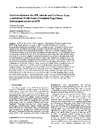Please use this identifier to cite or link to this item:
https://accedacris.ulpgc.es/handle/10553/50064
| Title: | Zonal circulation in the NW Atlantic and Caribbean from a meridional World Ocean Circulation Experiment hydrographic section at 66°W | Authors: | Joyce, Terrence M. Hernandez-Guerra, Alonso Smethie, William M. |
UNESCO Clasification: | 251007 Oceanografía física | Keywords: | Western Boundary Current North-Atlantic Gulf-Stream Water Sea, et al |
Issue Date: | 2001 | Journal: | Journal of geophysical research. Oceans | Abstract: | A World Ocean Circulation experiment Hydrographic Program section along 66°W in the North Atlantic was made in 1997. In addition to the usual variables (hydrographic and tracer) measured in WOCE onetime sections, we made lowered acoustic doppler current profiler (LADCP) measurements at nearly all of the stations. The section closed off a portion of the western North Atlantic to the west of the line, making a closed volume for constraining the circulation. In addition, the deep portions of the Caribbean do not communicate with the rest of the basin. By combining mass, silica, and LADCP information as constraints an inverse calculation obtained reveals a strong eastward transport in the Gulf Stream bounded by westward flowing water on either side. Within these energetic flows we see evidence for recently ventilated Classical Labrador Sea Water, which has not reached the Deep Western Boundary Current north of Puerto Rico in any significant amounts. Within the Caribbean our major new finding is a deep cyclonic circulation below sill depth in excess of 100 times the inflow of deep Atlantic water through the major deep sill: the Anegada‐Jungfern Passage. The signature of the deep Atlantic source water is most prominent in CFCs and both a bottom and mid‐depth maximum are present in the Caribbean to the south of Puerto Rico. Off the coast of Venezuela, however, only the deeper CFC maximum is found. For the entire section the net overturning circulation, heat flux, and freshwater fluxes are all consistent with expectations based on water mass formation and air‐sea exchanges to the west of our section, but the annual mean air‐sea fluxes of heat and freshwater from Comprehensive Ocean‐Atmosphere Data Sets appear somewhat too small in comparison with our single‐section result. | URI: | https://accedacris.ulpgc.es/handle/10553/50064 | ISSN: | 2169-9275 | DOI: | 10.1029/2000JC000268 | Source: | Journal of Geophysical Research: Oceans [ISSN 2169-9275], v. 106 (C10), p. 22095-22113 |
| Appears in Collections: | Artículos |
SCOPUSTM
Citations
52
checked on Jun 8, 2025
WEB OF SCIENCETM
Citations
45
checked on Jun 8, 2025
Page view(s)
122
checked on Oct 12, 2024
Download(s)
150
checked on Oct 12, 2024
Google ScholarTM
Check
Altmetric
Share
Export metadata
Items in accedaCRIS are protected by copyright, with all rights reserved, unless otherwise indicated.
